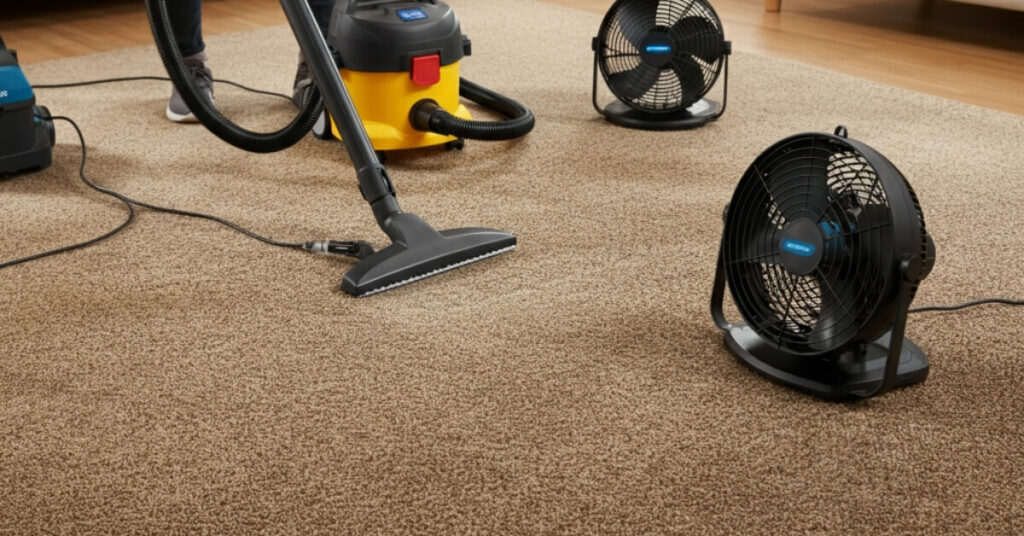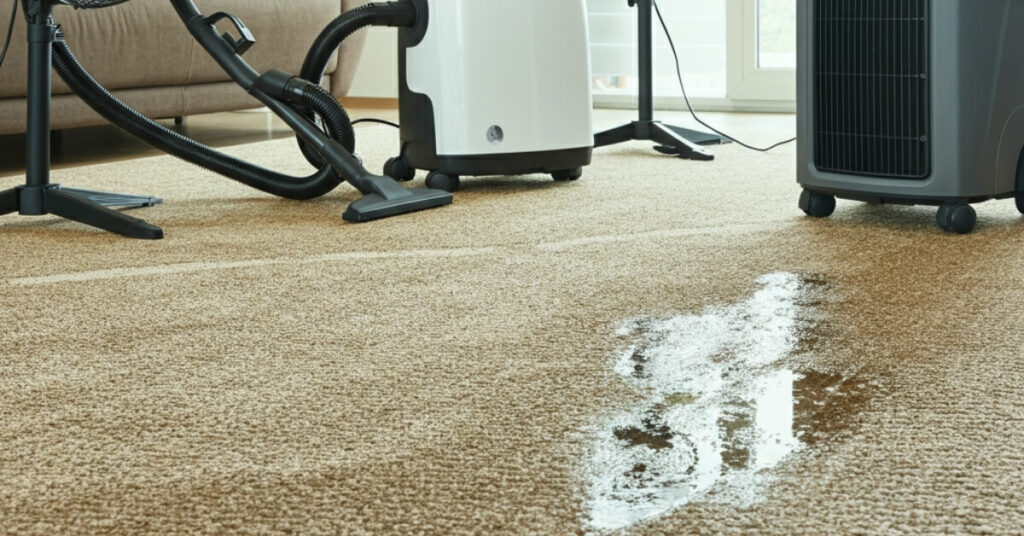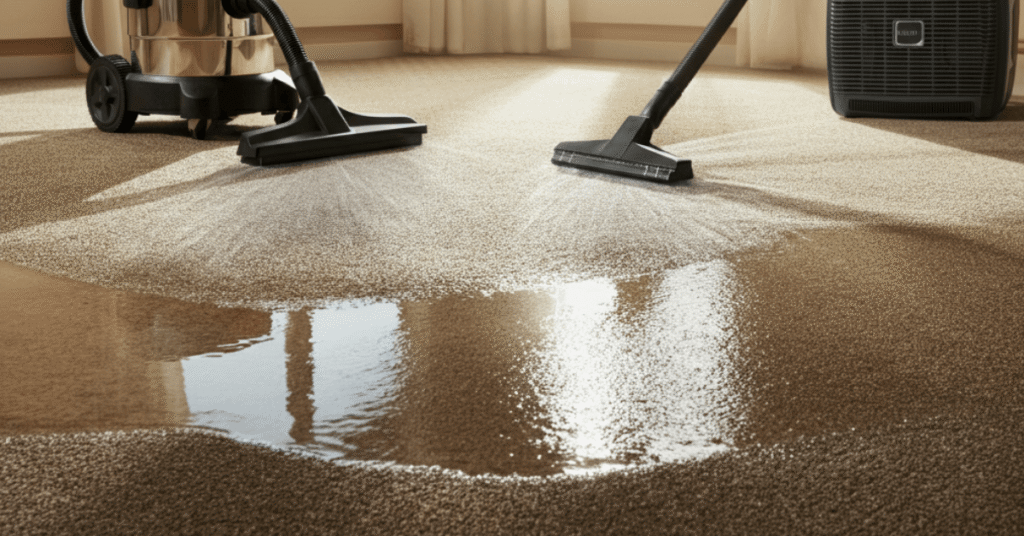Water damage to your carpet can happen in an instant, but the consequences can last for months if not handled properly. Learning how to dry your wet carpet fast is essential to prevent mold growth, structural damage, and expensive replacements. Whether you’re dealing with a burst pipe, flooding, or a simple spill, acting quickly can save your carpet and your wallet.
The key to successful carpet drying lies in removing moisture as thoroughly and rapidly as possible. Every hour you delay increases the risk of mold and mildew taking hold, which can create health hazards and permanent damage. Furthermore, water can seep into the padding beneath your carpet and even reach the subfloor, potentially causing structural issues that extend far beyond the visible surface.
This comprehensive guide will walk you through proven methods to dry wet carpets effectively, helping you tackle everything from minor water incidents to major flooding situations. By following these steps immediately after water damage occurs, you can significantly reduce the likelihood of long-term problems and restore your carpet to its original condition.
Why It’s Important to Dry a Wet Carpet Quickly
Time is your most valuable resource when dealing with wet carpets. The longer moisture remains trapped in carpet fibers and padding, the greater your risk of facing serious complications that go well beyond surface-level damage.
Prevents Mold and Mildew Growth
Mold spores are naturally present in most indoor environments, but they need moisture to grow and multiply. When carpets remain wet for more than 24-48 hours, conditions become ideal for mold colonies to establish themselves. Additionally, these microorganisms can spread rapidly throughout your home’s air system, potentially causing respiratory issues and other health problems for your family.
Once mold takes hold in carpet fibers, removal becomes exponentially more difficult and expensive. Professional remediation may be required, and in severe cases, complete carpet replacement becomes the only viable solution.
Protects Flooring Underneath
Water doesn’t stop at your carpet’s surface. It penetrates through to the padding and can reach wooden subfloors, concrete slabs, or other foundation materials. Wooden floors are particularly vulnerable to water damage, as prolonged exposure can cause warping, rot, and structural instability.
Even concrete floors aren’t immune to problems. Excessive moisture can lead to efflorescence (white, chalky deposits), cracking, and the growth of mold beneath your flooring materials. These issues often require extensive repairs that cost far more than addressing the wet carpet promptly.
Avoids Permanent Damage and Costly Replacements
Quick action to dry wet carpets can mean the difference between a minor inconvenience and a major home renovation project. Carpets that dry within the first 24-48 hours often return to their original appearance and functionality. However, those left wet for extended periods may develop permanent staining, shrinkage, or texture changes that make replacement necessary.
The financial impact extends beyond just the carpet itself. You may need to replace padding, treat or replace subflooring, and address any mold remediation needs. These cascading costs can easily reach thousands of dollars, making immediate carpet drying a smart investment in your home’s value.
How to Dry a Wet Carpet Fast (Step-by-Step Guide)

Taking systematic action is crucial when you discover wet carpeting in your home. This step-by-step approach will help you dry your carpet efficiently while minimizing potential damage.
Remove Excess Water
Start by extracting as much standing water as possible using a wet/dry vacuum. Work in overlapping sections, moving slowly to allow the vacuum maximum time to pull water from the carpet fibers. If you don’t have a wet vacuum, use clean towels to blot and absorb water, pressing firmly to draw moisture from deep within the pile.
For larger areas with significant water accumulation, consider renting a professional-grade water extraction unit from a home improvement store. These powerful machines can remove substantially more water than household vacuums, giving you a significant head start on the drying process.
Increase Airflow
Proper air circulation is fundamental to fast carpet drying. Position multiple fans around the affected area, creating cross-ventilation that keeps air moving across the wet surface. Box fans, pedestal fans, and even ceiling fans all contribute to the drying process.
Open windows and doors whenever possible to promote natural airflow, but be mindful of outdoor humidity levels. If the outside air is more humid than your indoor environment, keep windows closed and rely on mechanical ventilation instead. The goal is to move dry air across your carpet while removing moisture-laden air from the space.
Use Dehumidifiers
Dehumidifiers work alongside fans to create optimal drying conditions by removing excess moisture from the air. This prevents the air from becoming saturated, which would slow the evaporation process from your carpet. Place dehumidifiers strategically around the room, ensuring they have adequate space for air intake and exhaust.
For best results, aim to maintain indoor humidity levels between 30-50% during the drying process. Most dehumidifiers include built-in humidity monitors, or you can purchase a separate hygrometer to track progress. Remember to empty the water collection tank regularly to maintain peak performance.
Lift the Carpet If Needed
In cases of extensive water damage, lifting the carpet from the tack strips allows air to circulate underneath and helps dry the padding more effectively. This step requires some care to avoid damaging the carpet or injuring yourself on the tack strips’ sharp points.
Use a putty knife or similar tool to carefully separate the carpet edges from the tack strips. Once lifted, you can position fans to blow air directly onto the carpet backing and padding. This technique dramatically reduces drying time and helps prevent mold growth in these harder-to-reach areas.
Apply Baking Soda for Moisture and Odor
After removing excess water, sprinkle a generous layer of baking soda across the entire wet area. Baking soda naturally absorbs moisture while neutralizing odors that may develop during the drying process. Allow the baking soda to sit for several hours or overnight, then vacuum it up thoroughly.
This step is particularly important if the water damage involved contaminated water or if you notice any musty odors developing. The baking soda treatment can prevent minor odor issues from becoming major problems as your carpet dries.
Best Tools & Equipment for Fast Carpet Drying
Having the right equipment can significantly reduce your carpet drying time and improve your results. While you may not have all these tools readily available, many can be rented or borrowed when needed.
Wet/Dry Vacuum
A quality wet/dry vacuum is your first line of defense against water damage. Look for models with strong suction power and large capacity tanks to minimize emptying frequency. Professional-grade units available at rental centers offer superior performance for extensive water damage situations.
When using any wet vacuum, work methodically across the entire affected area, overlapping your passes to ensure thorough water extraction. Don’t rush this step, as removing water mechanically is much faster than waiting for it to evaporate naturally.
High-Powered Fans
Industrial fans move significantly more air than household fans, making them invaluable for rapid carpet drying. Centrifugal air movers, commonly used by water damage professionals, are particularly effective because they create focused, high-velocity airflow that penetrates carpet fibers efficiently.
Position fans at angles that direct airflow across the carpet surface rather than straight down. This creates better air movement and prevents the formation of stagnant air pockets that slow the drying process.
Carpet Dryers
Specialized carpet drying equipment combines powerful airflow with heat to accelerate moisture removal. These units are designed specifically for carpet drying applications and often include features like adjustable airflow patterns and temperature controls.
While carpet dryers represent a significant investment for occasional use, they’re available at most equipment rental centers. For extensive water damage or valuable carpets, the rental cost is often justified by the superior drying performance they provide.
Dehumidifiers
Commercial-grade dehumidifiers remove moisture from the air much more efficiently than residential units. They’re particularly valuable in humid climates or during seasons when natural ventilation isn’t practical. Look for units with large water collection capacities and continuous drainage options for extended operation.
Position dehumidifiers centrally in the affected room and ensure adequate clearance around air intake and exhaust vents. Running dehumidifiers continuously during the first 24-48 hours after water damage provides the best results.
Moisture Meters
Moisture meters take the guesswork out of determining when your carpet is truly dry. These instruments measure moisture content in carpet fibers and padding, helping you avoid the mistake of assuming your carpet is dry based on surface appearance alone.
Pin-type moisture meters provide the most accurate readings for carpet applications. Test multiple areas throughout the affected space and compare readings to completely dry carpet areas to establish when drying is complete.
How to Handle Different Carpet Types

Different carpet materials and constructions require specific drying approaches to prevent damage and ensure optimal results. Understanding your carpet type helps you choose the most appropriate drying methods.
Wool: Gentle Drying, Avoid Heat
Wool carpets require careful handling during the drying process due to their natural fiber composition. High temperatures can cause wool fibers to shrink, distort, or felt together, creating permanent damage that makes the carpet unsalvageable.
Focus on room-temperature airflow and dehumidification when drying wool carpets. Avoid direct sunlight, heated fans, or other heat sources that might exceed safe temperature limits. Instead, maximize air circulation and be patient with the longer drying times that wool typically requires.
Professional cleaning may be necessary for valuable wool carpets exposed to significant water damage. The investment in professional drying often pays for itself by preserving the carpet’s appearance and extending its lifespan.
Synthetic: Faster Drying, Less Sensitive
Synthetic carpet materials like nylon, polyester, and polypropylene are generally more resilient to water damage and respond well to aggressive drying methods. These materials can typically handle higher temperatures and more intense airflow without suffering damage.
You can safely use heated fans, carpet dryers, and other equipment that might damage natural fibers. This allows for faster drying times and more flexibility in your approach. However, always check manufacturer guidelines if available, as some synthetic carpets have specific care requirements.
Berber: Slow to Dry, Needs Airflow Underneath
Berber carpets, with their dense, looped construction, tend to trap water more effectively than cut-pile carpets. The tight weave that makes Berber durable also makes it challenging to dry, particularly if water reaches the backing material.
Pay special attention to creating airflow underneath Berber carpets by lifting edges when possible. The dense construction requires more time and patience, but thorough drying is achievable with proper technique. Consider professional assistance for valuable Berber carpets with extensive water damage.
Plush: Thick Pile, Requires Thorough Moisture Removal
Plush carpets with thick, dense pile present unique drying challenges due to their ability to hold large amounts of water deep within the fiber structure. Surface drying may occur relatively quickly, but moisture can remain trapped near the backing for extended periods.
Use moisture meters to verify that deep moisture has been eliminated, not just surface moisture. Plush carpets often benefit from lifting and direct airflow to the backing material. Don’t assume the carpet is dry based on surface appearance alone, as hidden moisture can lead to mold growth and odor problems later.
Take Action Now to Save Your Carpet
Wet carpet situations demand immediate attention and systematic action. The methods outlined in this guide can help you dry your carpet effectively and prevent the costly complications that come with delayed response. Remember that every hour counts when dealing with water damage, and the investment in proper drying equipment and techniques pays for itself by protecting your home and health.
Start with water extraction, maximize airflow and dehumidification, and monitor progress with moisture meters when possible. Don’t hesitate to seek professional help for extensive damage, valuable carpets, or situations involving contaminated water. Your quick action now can save you thousands of dollars in replacement costs and remediation expenses later.
FAQs
How long does it take for a wet carpet to dry?
Yes, most wet carpets take 24-72 hours to dry completely with proper equipment and conditions. Factors like carpet thickness, humidity levels, and airflow affect drying time.
Can I use a hair dryer to dry my carpet?
No, hair dryers are not effective for carpet drying due to their small coverage area and limited airflow. Use fans and dehumidifiers for better results.
What if my carpet smells after drying?
Yes, lingering odors often indicate incomplete drying or bacterial growth. Apply baking soda, increase ventilation, and consider professional cleaning if odors persist.
Should I remove the carpet padding?
Yes, severely water-damaged padding should be removed and replaced, as it’s difficult to dry thoroughly and prone to mold growth.
Can professional cleaning help with water damage?
Yes, professional water damage restoration services have specialized equipment and expertise that can save carpets that might otherwise need replacement.


